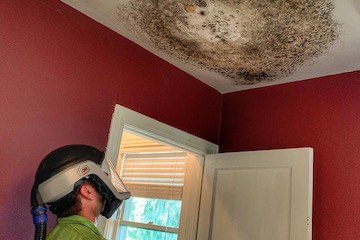

When it comes time to tackle the potential presence of mold in your home, you may not know what specifically to research or which companies to call.
This is because the mold process often involves two separate steps that can be conflated and misconstrued as the same thing: mold assessment and mold testing.
You may find yourself wondering, “What is the difference? And who should I call for help?”
What Is Mold Testing?
A mold test, otherwise referred to as mold sampling, is the process used to determine what type of mold growth is present based on a sample taken of the air or a solid surface.
Mold testing an air sample most commonly uses a “spore trap,” which involves setting up a sticky surface to catch mold spores that pass through via airflow. A surface sample, on the other hand, may involve using swabs, clear tape samples, or the removal of the surface itself to inspect in a lab setting.
The problem with mold testing? It’s not a valuable stand-alone service in that it does not provide you with complete information. While testing serves to determine what kind of mold is present after it’s found, it does not provide the full context for that growth.
In other words, you’re left with a series of key questions:
“Where else might this mold be present?”
“Why is the mold growing here?”
“If I change the air temperature/air-filters/etc, will that stop the growth?”
What Is A Mold Assessment?
A mold assessment, also called a mold inspection, is when a hired professional inspects a given building or area to determine whether mold growth is present and, if so, why. Particularly, as mold cannot always be seen, mold assessments should involve searching for evidence of both past and current mold growth.
The American Society for Testing and Materials also specifies the standards that those professionals should adhere to during their search (referred to as the ASTM D7338-14), which upholds a certain caliber for quality scientific processes and techniques.
For example, a mold assessment should include inspection of a building’s moisture and humidity levels, as water vapor and leakage can cause and/or contribute to fungal growth. Additionally, professionals should enter and review isolated spaces that might not otherwise be open and visible to the building’s inhabitants, such as crawlspaces, attics, or the spaces between walls.
Thus, where mold testing merely sheds light on the type of mold that is already present, mold assessments provide the bigger picture to an overarching problem and equip you with the ability to take action.
What Do I Do Now?
Here at Luce Air Quality, we provide a comprehensive 3-step professional mold assessment, where we conduct an inspection and diagnostic survey of your property, formulate a hypothesis, and test samples to substantiate our findings — the results of which are often returned to you the same day!
Our multi-step process is executed with the ultimate goal of providing you with a solution that you can trust, thus restoring your sense of comfort and safety in your own space.
Ready to learn more? Then contact us today by calling Luce Air Quality at (904) 803-1014! We look forward to restoring and enhancing your indoor air quality.


